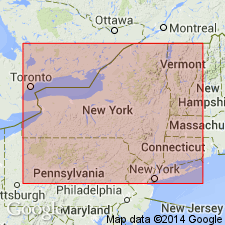
- Usage in publication:
-
- Barnes Gully bed
- Modifications:
-
- First used
- Dominant lithology:
-
- Phosphate
- AAPG geologic province:
-
- Appalachian basin
Summary:
Overlying the Kashong Member of the Moscow Formation is a newly recognized but yet unnamed member of the Moscow, which extends from Hamilton in the Chenango Valley to just west of Bristol Valley where it is absent due to erosional truncation. At the base of this interval is a 20- to 30-cm-thick distinctive phosphate nodule-bearing, fossil-rich bed herein termed the Barnes Gully bed. Previously considered to be lateral equivalent of the Little Beards phosphate at the base of the Windom Shale, but actual position is lower in the stratigraphic section. The bed is named for excellent exposures along Barnes Gully on the west side of Canandaigua Lake. The bed splits locally into two layers of concretionary limestone. Contains abundant brachiopods, bryozoans, crinoid debris, and other fossils irregularly distributed within a calcareous mudstone matrix. Bed appears to infill erosional furrows and burrows on a discontinuity surface. In addition to the Barnes Gully, the unnamed member includes three more distinctive marker beds: the MEGASTROPHIA beds, the Curtice Road bed, and the Geer Road bed. Age is Middle Devonian (Givetian).
Source: GNU records (USGS DDS-6; Reston GNULEX).
For more information, please contact Nancy Stamm, Geologic Names Committee Secretary.
Asterisk (*) indicates published by U.S. Geological Survey authors.
"No current usage" (†) implies that a name has been abandoned or has fallen into disuse. Former usage and, if known, replacement name given in parentheses ( ).
Slash (/) indicates name conflicts with nomenclatural guidelines (CSN, 1933; ACSN, 1961, 1970; NACSN, 1983, 2005, 2021). May be explained within brackets ([ ]).

